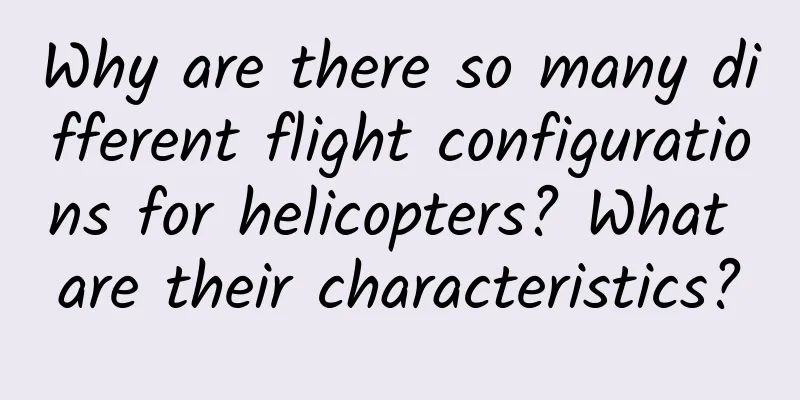Why are there so many different flight configurations for helicopters? What are their characteristics?

|
Compared with fixed-wing aircraft, helicopters can take off and land vertically, and can fly at low and ultra-low altitudes, "as high as a tree". They can play a prominent role in industrial production, disaster relief, military operations, etc. Countries around the world attach great importance to the development of helicopters, but there are not many countries that can independently develop and produce helicopters. Helicopter research and development must go through multiple stages such as demonstration, scheme design, engineering development, finalization and production. In the design stage, determining the configuration of the helicopter is a very important task. At present, there are many mature helicopter configurations applied to different helicopters. Which one is more perfect? 1. Single rotor with tail rotor configuration The single rotor with tail rotor is the most traditional configuration of helicopters. The main rotor installed horizontally above the nose provides the lift power, and the tail rotor is installed almost vertically at the tail. The tail rotor does not generate lift, and is mainly used to offset the anti-torque moment generated on the fuselage when the main rotor rotates. Although the diameter of the tail rotor is much smaller than that of the main rotor, it is indispensable. Once the tail rotor fails during flight, the helicopter will not be able to maintain its state, the fuselage will rotate in a spiral, and the altitude will drop rapidly. Figure 1 China's Z-20 helicopter (Photo source: Tencent) The single-rotor with tail rotor configuration is relatively simple and the technology is relatively mature. The largest number of helicopters choose this configuration. With the continuous advancement of new avionics equipment and new material technology, the continuous optimization of rotor configuration, and the improvement of engine power, single-rotor with tail rotor helicopters are constantly rejuvenating. 2. Twin-rotor configuration The tail rotor of a single-rotor helicopter with a tail rotor does not generate lift, but consumes about 10% to 15% of the engine power. Therefore, a twin-rotor helicopter has emerged, with two rotors turning in opposite directions, which can offset the anti-torque torque and do not require a tail rotor. 1. Tandem twin rotors At present, there is only one tandem twin-rotor helicopter in service in the world, the US CH-47 Chinook helicopter. The CH-47 is very eye-catching and recognizable in appearance. The two rotors on the top of the fuselage are connected in series, and there is no tail rotor. The two engines are at the rear of the fuselage. The rear rotor is installed higher than the front rotor to avoid collision between the two rotor blades. Figure 2 US CH-47 Chinook helicopter (Source: Tencent) Compared with a single rotor, the front and rear twin rotor layout improves flight stability, and the flight is less affected by the change of the helicopter's center of gravity. In particular, the hovering can be more stable and can meet the needs of special combat scenarios. The longer cabin has a larger space and can carry more personnel and supplies. However, the research and development threshold of the tandem twin rotor helicopter is high, the technology is complex, and the investment is large. In addition, the helicopter's control system is relatively complex, and the equipment support requirements and costs are high. (II) Coaxial twin rotors The coaxial twin-rotor is to install two rotors on the same rotating shaft, arranged up and down, with opposite rotation directions, so that the counter-torque can offset each other. Russia's Ka-28 and Ka-52 helicopters both use this layout. Figure 3 K-28 helicopter imported by China (Photo source: NetEase) Since there is no tail rotor, the length of the tandem twin-rotor helicopter can be greatly shortened and the structure is relatively compact. The two rotors also improve the flight stability of the helicopter, making it very suitable for use as a ship-borne helicopter. However, the two rotors are arranged up and down, which must increase the height of the helicopter. The Russian Ka-52 is 5.4 meters high, which is nearly 1-2 meters higher than ordinary helicopters. When the two rotors rotate, the airflow will interfere with each other. In some special cases, such as sudden wind changes during flight, the probability of blades flapping, deforming and colliding will increase greatly, which directly limits the flight overload of this type of helicopter. (III) Cross-type twin rotors The cross-rotor helicopter has two rotor shafts, which are arranged horizontally and tilted outward at a certain angle. The two rotors are cross-shaped above the fuselage, and the rotors are synchronously controlled by gear meshing, so there is no need to worry about collision under normal circumstances. The helicopter currently using this configuration is the K-MAX helicopter in the United States. Figure 4 US K-MAX helicopter (Source: Tencent) This strange helicopter has some of the flight advantages of a twin-rotor helicopter, but it is not widely used by the military. It is mainly used for lifting and hoisting tasks in the fields of civil construction, surveying, mining, logging, etc. The twin rotors of this type of helicopter are arranged horizontally, resulting in large aerodynamic resistance and complex flight control. 3. Hybrid Configuration The hybrid configuration is a more special configuration and also a development trend in the future. 1. Parallel twin rotors plus tilt The two rotors of the parallel twin-rotor are installed side by side on a helicopter, arranged left and right, rotating in opposite directions, and connected by a transmission shaft in the middle. The V-22 Osprey currently in service in the United States adopts this configuration. The rotors can tilt with the engine, changing from horizontal to vertical, and the helicopter flight mode is then changed to propeller flight mode. Figure 5 US V-22 Osprey flight status Helicopters of this configuration are also called tilt-rotor aircraft, and are actually no longer helicopters in the full sense of the word. The propeller flight mode can greatly increase the flight speed, and the maximum speed of the Osprey helicopter can exceed 500 kilometers per hour. However, the accident rate of this helicopter is more than 6 per 100,000 hours. The latest accident occurred on August 27, 2023, when a US MV-22B Osprey tilt-rotor aircraft crashed during an exercise in Australia. In addition, the research and development cost, production cost, and use cost of the aircraft are very high, and the cost of a single unit is 60 million US dollars. In 2019, Bell Corporation of the United States improved a V280 tilt-rotor aircraft based on the V-22 for the US Army's future long-range attack aircraft project. Figure 6 US V-280 verification aircraft flight ** (Photo source: Sohu.com)** The V-280 helicopter can fly twice as fast and far as a traditional helicopter. Compared with the V-22, the V-280 is equipped with a tilt gearbox, which allows the rotor drive shaft to change angles so that the engine remains unchanged when the rotor tilts. (II) Tandem twin rotors plus tail thruster Another helicopter competing with the V-280 in the U.S. Army's future long-range attack aircraft project is the S-97 helicopter, which is produced by Sikorsky and uses a tandem twin-rotor helicopter, but unlike the Russian tandem twin-rotor helicopter, the S-97 is equipped with a tail propeller. Figure 7 US S-97 verification aircraft flight (Photo source: Tencent) The S-97 integrates the latest technologies in fly-by-wire control, flight control, system integration, advanced materials, etc., reduces the fuselage size, reduces the noise signal, can reach a speed of more than 400 kilometers per hour, and can fly in plateau and high-temperature environments. In general, each helicopter configuration has its own strengths and weaknesses. When designing a helicopter, you must fully consider technology, cost, life, safety and other aspects before you can choose and determine it. Which helicopter configuration do you like best? Produced by: Popular Science of Chinese Military Technology Producer: Guangming Online Science Department Author: Lu Ying (military expert) Review expert: Liang Chunhui (military expert, military science writer) Planning: Jin He |
>>: Why did Oppenheimer become the leader of the Manhattan Project?
Recommend
If you have this in your shopping cart, please delete it immediately!
One minute with the doctor, the postures are cons...
How much does it cost to create a ticketing app in Shangluo?
In order to better penetrate into various industr...
How to operate and promote activities without money?
Event operators often face the embarrassing situa...
Electric Technology Car News: The price of Highlander is too high. The Changan CX70T, which starts at 90,000 yuan, will make your 7-seat SUV dream come true.
With the opening of the second-child policy, mid-...
Can Douyu and Huya rely on cloud gaming to return to the top?
Once upon a time, when people in China mentioned ...
How to plan a live e-commerce event?
Live streaming began to explode in 2015, sparking...
Google Play opens developer team in China
[[132708]] Chris Yerga, vice president of enginee...
How to increase the average duration of website visits?
The average browsing time of website users is one...
Can Nokia be reborn in the mobile phone industry?
Recently, Microsoft replaced Nokia with Microsoft...
With the advent of the "digital RMB", these industries will accelerate their demise, and practitioners should change their careers as soon as possible
The thing that each of us may be most inseparable...
[Smart Farmers] The power of seeds: Uncovering the "treasure genes" of the National Tea Germplasm Resource Garden
A tiny seed contains huge potential. An excellent...
Useful information | Product activity operation and promotion planning program!
Activities are a very important way to quickly at...
Dear advertiser, what misunderstanding do you have about advertising creativity?
A few days ago, a colleague sent me an App screen...
2018Q3 Wedding Photography Industry Advertising Report, Which Information Flow Ads Are More Popular?
As my country's economy is performing well ov...
Thinking about B-side new media operation
In recent days, my friends' circles have been...









